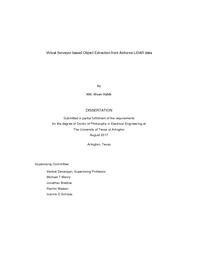
ATTENTION: The works hosted here are being migrated to a new repository that will consolidate resources, improve discoverability, and better show UTA's research impact on the global community. We will update authors as the migration progresses. Please see MavMatrix for more information.
Show simple item record
| dc.contributor.advisor | Devarajan, Venkat | |
| dc.creator | Habib, Md Ahsan | |
| dc.date.accessioned | 2017-10-02T14:39:29Z | |
| dc.date.available | 2017-10-02T14:39:29Z | |
| dc.date.created | 2017-08 | |
| dc.date.issued | 2017-08-11 | |
| dc.date.submitted | August 2017 | |
| dc.identifier.uri | http://hdl.handle.net/10106/26983 | |
| dc.description.abstract | Topographic feature detection of land cover from LiDAR data is important in various fields - city planning, disaster response and prevention, soil conservation, infrastructure or forestry. In recent years, feature classification, compliant with Object-Based Image Analysis (OBIA) methodology has been gaining traction in remote sensing and geographic information science (GIS). In OBIA, the LiDAR image is first divided into meaningful segments called object candidates. This results, in addition to spectral values, in a plethora of new information such as aggregated spectral pixel values, morphology, texture, context as well as topology. Traditional nonparametric segmentation methods rely on segmentations at different scales to produce a hierarchy of semantically significant objects. Properly tuned scale parameters are, therefore, imperative in these methods for successful subsequent classification. Recently, some progress has been made in the development of methods for tuning the parameters for automatic segmentation. However, researchers found that it is very difficult to automatically refine the tuning with respect to each object class present in the scene. Moreover, due to the relative complexity of real-world objects, the intra-class heterogeneity is very high, which leads to over-segmentation. Therefore, the method fails to deliver correctly many of the new segment features.
In this dissertation, a new hierarchical 3D object segmentation algorithm called Automatic Virtual Surveyor based Object Extracted (AVSOE) is presented. AVSOE segments objects based on their distinct geometric concavity/convexity. This is achieved by strategically mapping the sloping surface, which connects the object to its background. Further analysis produces hierarchical decomposition of objects to its sub-objects at a single scale level. Extensive qualitative and qualitative results are presented to demonstrate the efficacy of this hierarchical segmentation approach. | |
| dc.format.mimetype | application/pdf | |
| dc.language.iso | en_US | |
| dc.subject | LiDAR | |
| dc.subject | Object based image analysis | |
| dc.subject | Hierarchical object representation | |
| dc.subject | Object segmentation | |
| dc.title | Virtual Surveyor based Object Extraction from Airborne LiDAR data | |
| dc.type | Thesis | |
| dc.degree.department | Electrical Engineering | |
| dc.degree.name | Doctor of Philosophy in Electrical Engineering | |
| dc.date.updated | 2017-10-02T14:41:36Z | |
| thesis.degree.department | Electrical Engineering | |
| thesis.degree.grantor | The University of Texas at Arlington | |
| thesis.degree.level | Doctoral | |
| thesis.degree.name | Doctor of Philosophy in Electrical Engineering | |
| dc.type.material | text | |
| dc.creator.orcid | 0000-0003-1732-3327 | |
Files in this item
- Name:
- HABIB-DISSERTATION-2017.pdf
- Size:
- 5.750Mb
- Format:
- PDF
This item appears in the following Collection(s)
Show simple item record


